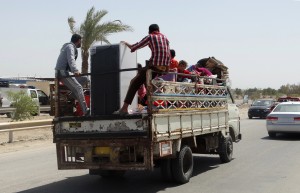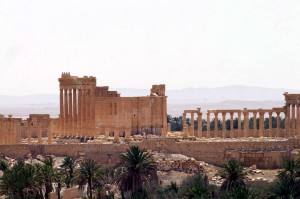
BEIRUT — Islamic State militants seized parts of the Syrian town of Palmyra in pitched battles with government forces Wednesday, raising fears the extremists would destroy the majestic ancient ruins that are one of the region’s most renowned historical sites.
Home to a UNESCO world heritage site, Palmyra is famous for its 2,000-year-old towering Roman-era colonnades. Before the war, thousands of tourists a year visited the remote desert outpost, also known as the “Bride of the Desert.”
The Britain-based Syrian Observatory for Human Rights said the militants gained control of as much as a third of the town in heavy clashes Wednesday.
“I am terrified,” said Maamoun Abdulkarim, Syria’s director-general of antiquities and museums. “This is a PR battle for Daesh, and they will insist on scoring victory against civilization by destroying” the ancient ruins, he said, using the Arabic acronym for the group.
The fall of Palmyra into the militants’ hands would be an enormous loss to the Syrian government, not only because of its cultural significance, but because it would open the way to key government-held areas including Homs and Damascus.
Homs governor Talal Barazzi said Islamic State militants infiltrated overnight into some districts in the northern part of Palmyra, adding that there were ongoing street battles and snipers in the streets. “The situation is delicate,” he said.
He said 19 people were killed Wednesday, including seven civilians and 12 from the pro-government militia known as the National Defense Forces.
Abdulkarim said workers were able to save hundreds of statues and masterpieces from Palmyra that were transported to safe houses in Damascus. “But how do you save colonnades that weigh a ton, how do you save temples and cemeteries and, and, and?” he asked.
Abdulkarim appealed to the international community to declare “a red line” around Palmyra and called on the U.S.-led coalition to “at least prevent IS convoys from reaching it.”
The majority of the ruins are located in Palmyra’s south, and the militants entered Wednesday from the north after seizing the state security building from government forces. But their presence has sparked concerns they would destroy the ruins as they have done with major archaeological sites in neighboring Iraq.
Syrian antiquities expert and opposition figure Amr Al-Azm noted the irony of anti-Assad activists having to call on the U.S.-led coalition to support Assad’s forces in the city against IS.
“We are trapped in a sickening paradox where, to save the world heritage site of Palmyra, we are forced to call on the international community and the coalition to attack ISIS forces in support of the Syrian regime, which is defending the city,” he wrote in a Facebook post this week.

The Islamic State group’s advance on Syria’s central region to the outskirts of Palmyra followed a major military victory in neighboring Iraq, where the militants captured the strategic city of Ramadi, capitol of the country’s largest Sunni province, over the weekend.
Thousands of displaced people fleeing the violence in Ramadi and western Anbar province poured into Baghdad on Wednesday after the central government waived restrictions and granted them conditional entry.
The exodus is the latest in the aftermath of the fall of Ramadi. The Shiite-led government in Baghdad is struggling to come up with a plan to reverse the astonishing loss, pledging a counter-offensive and relying on Iranian-backed Shiite militiamen to join the battle.
Athal al-Fahdawi, an Anbar councilman, said thousands of civilians from Ramadi, who were stranded on open land for days, are now being allowed to cross a bridge spanning the Euphrates River and enter Baghdad Province.
On Tuesday, Anbar officials said five of the displaced residents had died from exhaustion in the Bzebiz region, where the displaced had been forced to stay while they were kept away from Baghdad.
According to the International Organization for Migration, more than 40,000 people have been displaced from Anbar since Friday, when the militants began their final push for Ramadi. In the past, people fleeing the Sunni province have been prevented from entering Baghdad due to fears that militants might mingle in with the crowds and sneak into the Iraqi capitol.
Residents still left in Ramadi told The Associated Press by telephone Wednesday that Islamic State militants were urging them over loudspeakers not to be afraid and to stay in the city. However, they were not preventing those wanting to leave the city to go, the residents said, speaking on condition of anonymity for fear for their safety.
It is still unknown when the Iraqi government’s expected wide-scale operation to recapture Ramadi and other cities will start. Baghdad officials and leaders of the so-called Popular Mobilization Units, Shiite militias who are fighting on the side of the Iraqi military and security forces, have repeatedly said they need time for a military buildup and reconnaissance.
When the Islamic State launched its blitz last year and entire cities and towns fell into the hands of the militants, the Iraqi government at first took only defensive measures, and in many cases, soldiers and Iraqi forces abandoned their posts and fled in the face of the IS assault.
Military operations to retake entire swaths of Iraq that had fallen to IS began only months later. The U.S. launched its airstrike campaign in August.
Meanwhile, police officials said, a roadside bomb hit a minibus in Baghdad’s northern Shiite suburbs of Husseiniyah, killing two passengers and wounding seven, while a bomb near a wholesale market in southern Baghdad killed two people and wounded five. The officials spoke on condition of anonymity because they were not authorized to talk to the media.
There was no immediate claim of responsibility for the attacks, but Islamic militants frequently claim such bombings. Elsewhere in Baghdad, three bodies with gunshot wounds to the head and chest were found Wednesday in different parts of the city. The police said there were no IDs with the bodies.
Dead bodies left in the street were a common occurrence during the widespread sectarian violence that engulfed Iraq several years ago.




